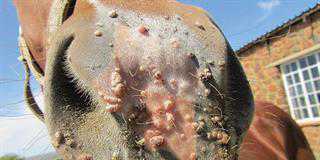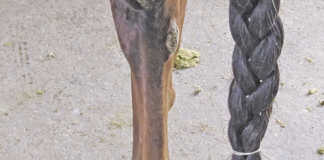It is safe to say that any change in behaviour is a sign that something is wrong with your horse. This is, after all, the way horses try to ‘communicate’ with their owners. And when a horse suddenly starts biting, chances are that it is experiencing some form of discomfort.
You then need to go through a process of elimination. Firstly, get a vet to check your horse. This will rule out any obvious cause of pain or discomfort. Next, have your equine dentist examine the horse’s teeth. (Teeth should be routinely checked every six months.)

A horse’s ‘personal space’ is as much as 6m. A nervous animal in its small stable may feel trapped and threatened if someone walks past and bite as a result.
If neither the vet nor the dentist finds anything out of the ordinary, it’s time to consider other sources of stress. Biting could be a sign of a lack of confidence, for example, especially if the horse feels threatened.
If your horse starts acting aggressively, this is likely to make you agitated. Your horse in turn will pick up on this and become even more nervous and threatened. This cycle has to be broken if you want to help your horse overcome the stress that led to the biting in the first place.
Stay cool and calm
The best approach is to treat your horse in a relaxed manner. Make it understand that you have time to do things slowly (without compromising your personal boundaries). Many mares turn aggressive and bite after having a foal. The foal is new and very demanding and the mare has no idea how to cope.
Make sure that feeding times are constant and there is no unnecessary excitement around the stables. Bear in mind that a horse’s ‘personal space’ extends out about 6m. Its space can be invaded by someone walking past the stable door. An insecure horse may think the person is a threat and lunge at the door.
Be quick and firm
But how do you actually get your horse to stop biting?
Put your hand between the horse’s face and the head collar, taking care to watch the animal closely. When it seems on the verge of nipping you, push its head away from you and say “No!” sharply. Then slowly bring back its head toward you and rub it between the eyes.
Repeat this until the horse realises nipping is a bad idea. Be quick and firm. Make sure the horse knows it’s bad to nip. Horses learn very quickly that being close to you (rubbing it between the eyes) is rewarding and biting gets it pushed away. Very often the owner
of the horse is the person who spends the least amount of time with the animal. The groom does most of the handling and needs to be calm and happy – or else the horse will be distressed. Try to spend more time with your horse doing
basic exercises; this will not only strengthen your bond with your horse but increase the animal’s confidence.
As with humans, not every horse gets along with every other horse. Therefore, it’s a very good idea to put horses that get along next door to each other in stables and paddocks. When moving your horse, be mindful of the friendships they are leaving behind.
Finally, take into consideration a horse’s 6m personal space limit. Most stables are 4m by 4m, so there is already a degree of overcrowding. Not all horses have the emotional make-up to handle this stress and the problem may manifest in biting.
Placing a horse like this into a bigger space for a short period may help to calm it down and so ease the nervousness and biting behaviour.













